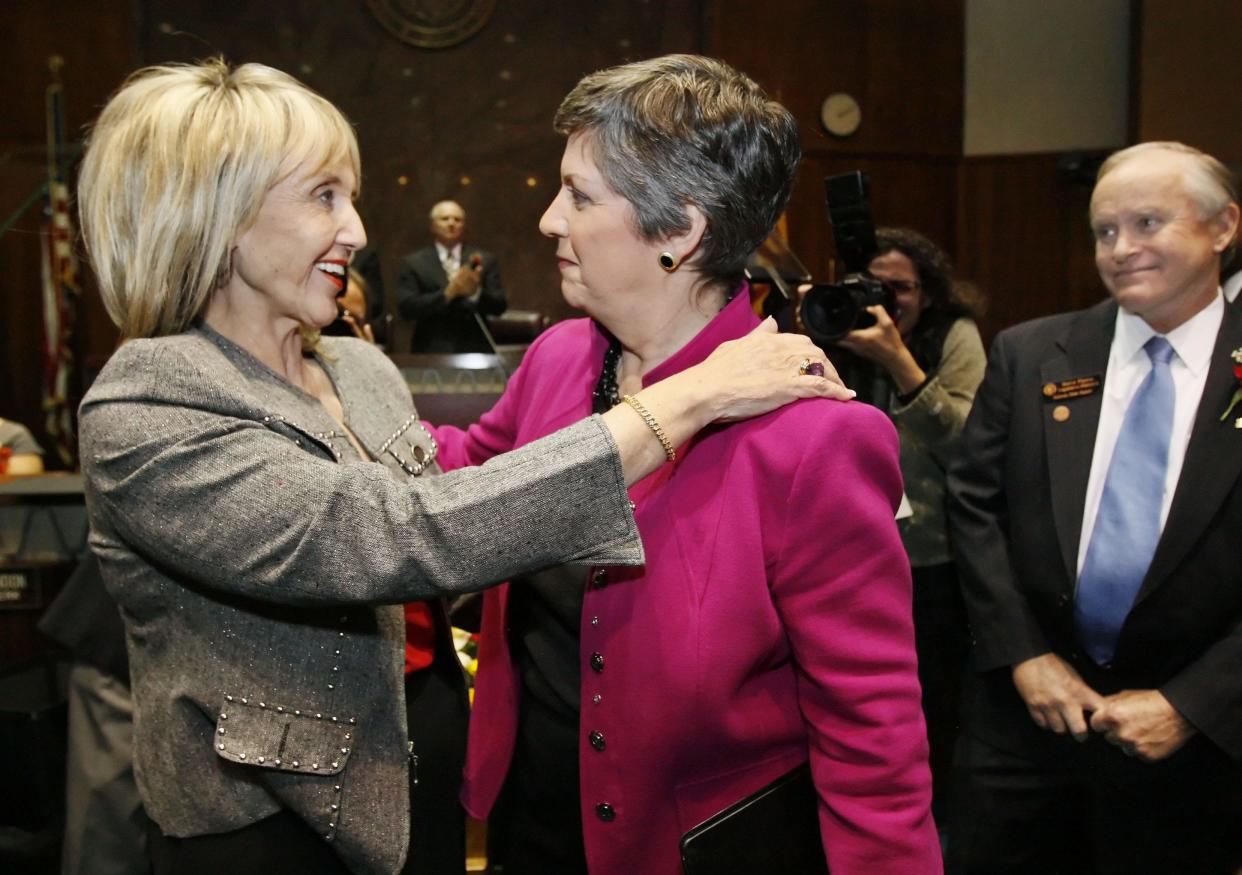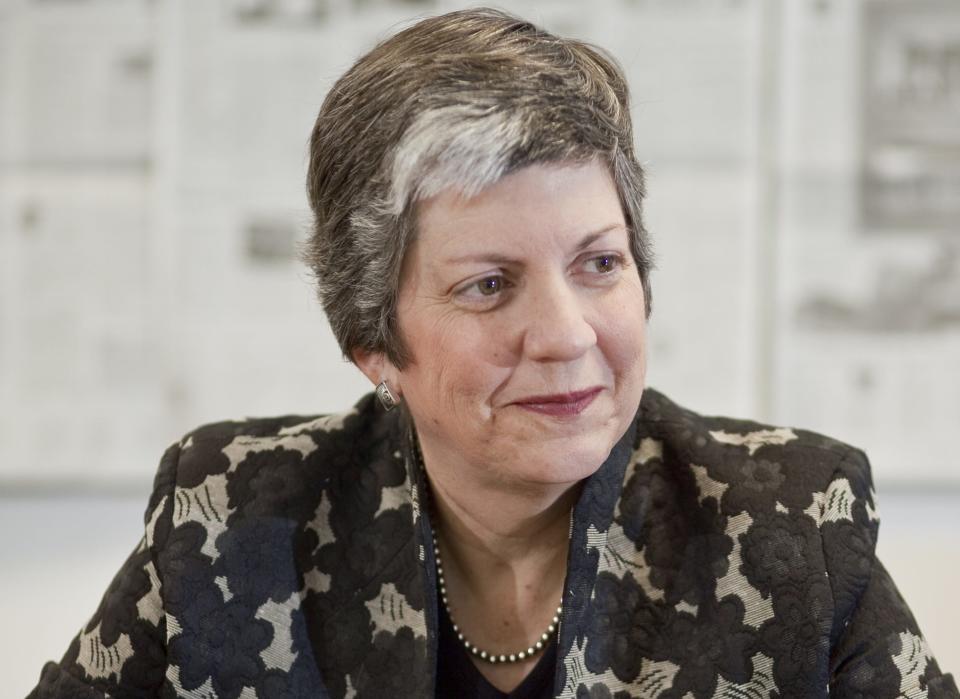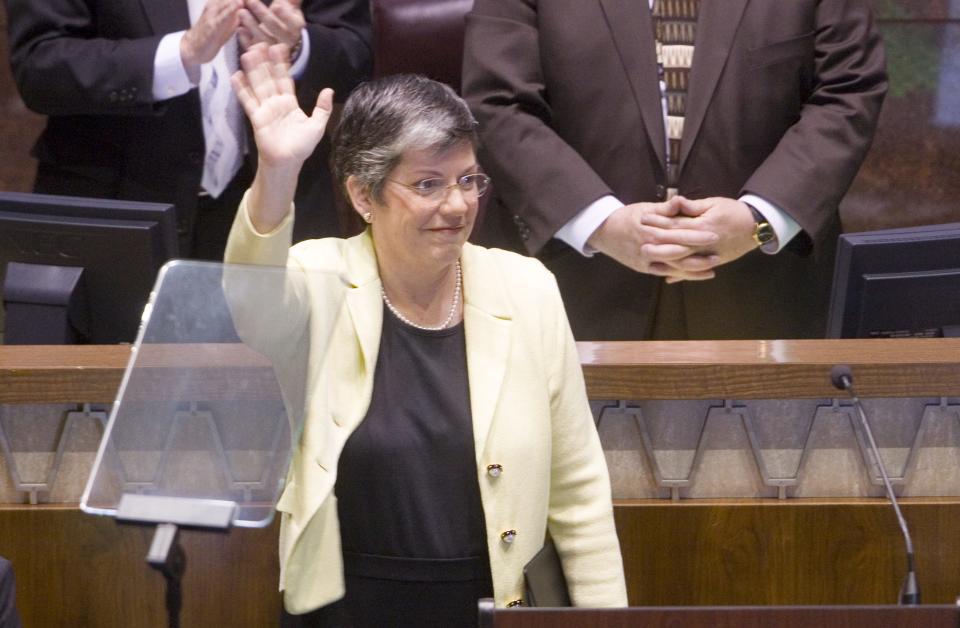The Arizona climate that could have been: How Napolitano would put the state back on track

- Oops!Something went wrong.Please try again later.
The Monday in January when Janet Napolitano took office as Arizona's first Democratic governor in a decade was warm, but not exceptionally so. The high of 65 degrees fit in the upper range of normal for temperatures recorded in Phoenix on the sixth day of each new year.
In that 2003 swearing-in, illuminated by Arizona's famous sunshine, Napolitano made history by becoming the first woman to directly succeed another female governor, her Republican predecessor Jane Dee Hull. She also seemed to many like someone who might take Arizona, with its capital city one of the hottest in the country, in a new direction on the rising issue of climate change.
When Napolitano stepped to the lectern to deliver her inaugural address, it had been 5,310 days since NASA climate scientist James Hansen alerted the world to the hazards of human-caused global warming in his 1988 congressional testimony.
She started with hope.
"Arizonans look on and ask: Will anything really change? My friends, I say to you today we are already changing."
She followed with a sobering reminder of challenges ahead.
"Put simply, there are no painless solutions to our problems. To emerge from this (economic) quagmire, we need patience, discipline and a long-term vision of a new Arizona."
Napolitano ended her speech with a pledge.
"We will not mortgage our future to make up for the mistakes of the past. We must sacrifice short-term rewards and agendas, and keep our eyes on a larger prize: a new Arizona where hope and opportunity abound."
Afterward, they celebrated at the Phoenix Science Museum. The future seemed bright. The concentration of carbon dioxide in the atmosphere was at 375 parts per million. The Maricopa County Department of Public Health had not yet started tracking annual heat deaths.

Sliding climate doors
Just over six years later, in the middle of her second term as governor in 2009, Napolitano was named by then-President Barack Obama as his new secretary of Homeland Security. She was in that role for four years before becoming president of the University of California system in 2013 and a professor at UC Berkeley's School of Public Policy in 2020, where she remains today.
The Arizona she left behind had been poised to take regional leadership on addressing climate change. During her first term, in 2006, Arizona founded the Southwest Climate Change Initiative with New Mexico. A year later, she signed Arizona up with the related Western Climate Initiative, which worked to link markets across state and country lines to reduce carbon emissions and foster international climate action.
Climate series beginning: Phoenix isn't what it once was because of climate change. But it's not too late to save it
Under Napolitano, Arizona developed a draft of its first statewide climate action plan. Her appointees to state agencies kept watch on dynamics on the Colorado River, while members of her new climate advisory group looked into how the state could get ahead of anticipated impacts in areas such as transportation, energy generation, agriculture and land use. It was as climate proactive as red states in the American Southwest got.
But when she left, everything changed.
“For a while, things were a little more collaborative relative to siting of renewables and setting clean air standards," said Sandy Bahr, director of the Grand Canyon Chapter of the Sierra Club, an environmental advocacy group that has endorsed Democratic candidate Katie Hobbs for governor. “Since Napolitano left, I can’t think of anything that has gone through the Legislature that has significantly advanced energy efficiency. Our last two governors have, by and large, let rules go forward that do not strengthen environmental protections overall."
Republican Jan Brewer took over from Napolitano and served as governor until 2015. She was succeeded by Republican Doug Ducey, whose second and final term ends this year.
"One of the first things that Jan Brewer did was issue an executive order to evaluate Napolitano's clean air standards," Bahr said. "Her Department of Environmental Quality director recommended that they not move forward with it. By the time Ducey was governor, there weren't a lot (of collaborative efforts) left. And then he did nothing to reverse any of the negative actions."
More state climate history: From hero to zero: Arizona was a leader in climate policy 15 years ago. What happened?
In the 13 years since Napolitano left Arizona, the atmospheric concentration of carbon dioxide, the most common greenhouse gas causing warming temperatures and more chaotic storms, has risen nearly 30 parts per million, from 387 to just under 416. It had taken 18 years, since 1991, for such an increase to occur prior to that.
Amid a record-setting drought that climate scientists are calling the new normal, the Colorado River has dried to the point that, in January, Arizona will see its allocation of river water cut by 21%, while groundwater pumping remains largely unregulated in rural areas. Local conversations about water conservation and turf removal are underway, but are behind those in states like Nevada and California, where Napolitano now resides.
Arizona still does not have a statewide climate action plan and has enacted some policies that limit the state's ability to address the problem, such as the 2010 law signed by Brewer the year after Napolitano left that prohibits state agencies from tracking and reporting greenhouse gas emissions.
Read our climate series: The latest from Joan Meiners at azcentral, a column on climate change that publishes weekly
In its 2022 Environmental Report Card for the Arizona Legislature and governor, the Sierra Club gave Ducey an F.
They considered his decisions on 10 bills with environmental potential between 2015 and now — some of which presented solutions to issues such as water infrastructure, electrification and coal combustion — and concluded that "his legacy on environmental issues is dismal."
“(Ducey's) office could have played a role in trying to get things scheduled and sending some direction to the Department of Transportation or to the Department of Environmental Quality on developing a climate resiliency plan," Bahr said. "But nothing. He didn’t use his office to advocate for any action on climate change. For a while, he wouldn’t even say the words 'climate change.'"
This inaction, Bahr says, has cost Arizona economic opportunities in the solar and electric vehicle industry, exacerbated health effects of heat and air pollution and allowed the state to dodge its responsibility in helping to limit global warming. Arizona is no longer listed as a member of the Western Climate Initiative.
Back in time: A conversation with Arizona's last climate-forward governor
To better understand where we've come from and where we may be headed on climate policy, The Arizona Republic spoke with Napolitano to relive the state's history on limiting warming. The following interview has been edited for length and clarity.
When you were in office in the 2000s, Arizona was emerging as a leader in climate action among Western states. Then you went to D.C. and state policy pivoted. Can you paint that picture a bit more for us?
Well, (let's see) what I can remember. I was elected in 2002, took office in 2003. So, 20 years ago now. Climate change, particularly at the state level, was just beginning to emerge as an issue. And it took many forms. One was on the water front. We were beginning to have discussions with the other states that were members of the Colorado River Compact. I appointed a state legislator from Yuma named Herb Guenther to be head of the Department of Water Resources, and he was leading Arizona's negotiations there.
Then I appointed Steve Owens to be head of (the Arizona Department of Environmental Quality). I asked Steve what steps Arizona needed to take to prepare for climate change, both in terms of reducing the amount of carbon emissions that we were responsible for, but also in terms of adaptation. What did Arizona need to do to be better prepared for global warming? And he really took a leadership role in formulating a state climate plan of action for Arizona, for us.
His plan was comprehensive, and we had taken several steps. Then I got busy running the Department of Homeland Security, where we were dealing with lots of natural disasters that were the result of climate change or were related to climate change. Lots of hurricanes, tornadoes, culminating in superstorm Sandy.
Political polarization is often cited as a reason climate policy has stagnated in more conservative states. How were you able to navigate this to make the progress you did with developing a state climate plan of action?
We were able to do many things just using the power of the executive branch, without necessarily having to go to the Legislature for statute, etc. And then we always had budget battles, including funding for DEQ and we just worked those through. I had to give a little to get a little and, fortunately, we were able to, particularly for that era, get a fair amount done.
What has changed between now and then in terms of passing climate legislation?
I think one of the differences is that climate change denialism was still very active. Many members of the Legislature were still denying human-caused climate change and that denialism was still reflected in the U.S. Congress.
I think the denialism has faded quite a bit. People can see the fires. They can see the impact of the drought. If you’re in Florida, you can see the hurricanes and the storm surges that result. People can see with their eyes the effects of climate change. So I don’t think that’s as powerful a movement now.
In terms of adaptation, there are lots of difficult questions involving how do you authorize rebuilding, who pays for it, what requirements need to be made for new buildings? Are building codes being updated to reflect the impacts of climate change? Are we adapting in a way (that's) ahead of the curve, not just to the risks that already have manifested themselves, but also to new or elevated risks that are anticipated? Is our public policy being adequately informed by the science?
Justice issues: Climate change could push produce prices higher, slowing fight for food justice
How can we approach finding answers to those questions in Arizona?
One way to think about it is you have things that can happen at the state level, but things that can happen at the municipal level are also very important. So, for example, I've heard that the mayor of Phoenix, Mayor Gallego, has been very active in terms of adapting Phoenix to climate change and to the changing heat patterns that are there. I've heard that there's an aggressive plan to plant more or to have more rooftops that are made of heat-resistant materials. There's an effort to restrict lawns (to save water) and to incorporate more trees into city planning. And so, where the state may be falling behind, I think some of the cities are moving ahead very aggressively.
What do you see as the differences between the situation you think we could have been in as a state if we had stayed on a path more aligned with your goals compared to where we are currently, with the water crisis and heat death toll worsening every year?
Well, there clearly was a difference in approach between myself and successors. I think it's too bad. I think we were on the right track. I think we were on a track to make Arizona a leader amongst the states. I think we were on a track to better position Arizona's potential for growth.
Taking affirmative actions to prevent the state from doing what it needs to do, it doesn't make any sense. If you think of Arizona as wanting to continue to grow and to diversify its economy and be a great place to live, then issues of climate and climate adaptation have to be factored in.
Monitoring: EPA released state-specific emissions reports. Arizona isn't on list
I would urge whomever is the next governor — obviously I’m supporting Katie Hobbs — that you can’t put climate on the back shelf, it has to be front and center.
To the extent that there has not been a sense of urgency here, Arizona and Arizonans are paying a price. If the goal of government is to help build a better future, you have to take into account the conditions on the ground as they exist now, and what changes need to be made to adapt to them.

What's at stake in the outcome of the current race for governor of Arizona?
Oh, so much. I mean, it's what kind of future Arizonans want and what kind of future they'll get. And it's everything from education, to economic development, to the environment and climate, to planning for and incorporating the population growth that I think is going to still occur.
What kind of water policy will be followed? And how does Arizona ensure that it has adequate potable water supplies for the population? There are real differences between the candidates for governor on all of those things.
If we elect someone willing to take action on the climate crisis, how do they get us back on track as a state?
First thing I'd do is take the climate plan that we had developed 20 years ago when I was governor and update it, and improve upon it and incorporate climate and climate planning at all levels, be it municipal, be it county, be it statewide. Take into account the new knowledge that we've garnered from science. There has been a terrific amount of science done in this area.
Look at what other states have done, and not necessarily copy them, but see whether there are some best practices that would make sense for Arizona. And then I would convene a summit of mayors and county officials and leaders in the private sector to say, you know, what is it that they are willing to do and what is it that they want the state to do vis-à-vis climate? And when I talk about climate, I mean not just reducing carbon emissions, but adaptation and resilience. That's where I'd start.
Joan Meiners is the climate news and storytelling reporter at The Arizona Republic and azcentral. Before becoming a journalist, she completed a doctorate in ecology. Follow Joan on Twitter at @beecycles or email her at joan.meiners@arizonarepublic.com.
Support climate coverage and local journalism by subscribing to azcentral.com at this link.
This article originally appeared on Arizona Republic: Arizona has lost its way on climate policy. Napolitano offers advice

